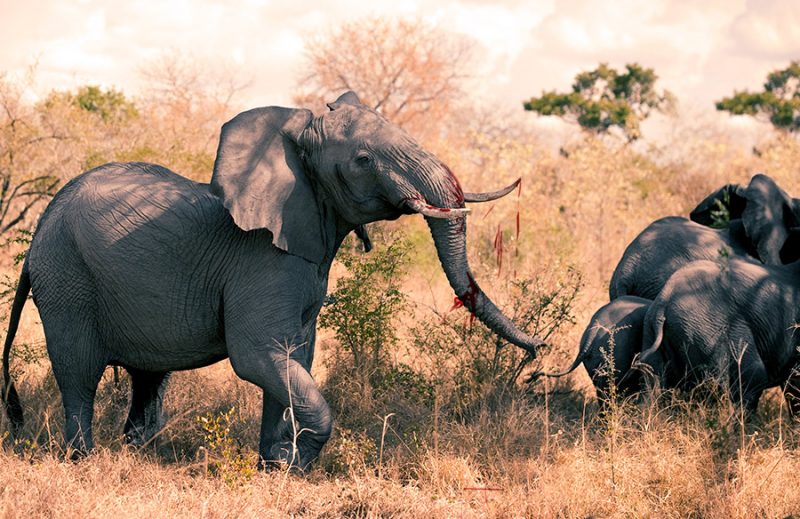With the recent death of a Saudi tourist who was trampled to death by an elephant during a game drive at a popular park in Uganda, elephants remain one of the most deadly mammals once aggrieved.
Leaving out hippos and possibly African buffalos, elephants kill more people than any other large land mammal. On average they’re responsible for close to 500 deaths a year. Should you find yourself in the bush and in a face-off with an angry elephant, it’s probably a good idea you don’t make the situation even worse than it is.
Elephants are the largest land animal on Earth and are really intelligent. The largest elephant ever weighed in at 24,000 lbs. It was a large male African elephant with a shoulder height of 13 feet and giant 11 foot tusks. The three living species of elephants evolved in Africa and Asia with not only deadly predators like lions and tigers, but also with humans.
They learn from their interactions in the wild and with humans and therefore found an aggressive way to sustain their way of life and family structure. They have developed a defensive strategy to avoid unnecessary conflict. In fact, they’re generally aggressive when heavily poached.

Elephants generally defend themselves by charging towards threats basically in two ways – bluff charges and attack charges.
Bluff charges are meant simply to stop a threat from advancing any further. The elephant wants you to know it means business, but isn’t going to actually attack you. It’s ears will be fanned out wide, making it appear larger. It will sway side to side, legs pivoting from one to the other, doing what is known as “displacement activities.” Its trunk will not be pinned up and under its body, but instead swaying side to side or hanging down below the elephant.
In attack charges, the elephant runs at you, trampling and impaling you with its tusks. It will precede all of this with a very different display behavior. Its ears will be pinned back on its head. The trunk will be curled up under them and inward. The elephant won’t display the so-called “displacement activities” that are mostly used to bluff charge. You’ll want to run.
How to survive an elephant attack
If an elephant does attack-charge you, it will use its tusks to gore you, throw you and crush you. It will often keep stomping until you’re dead. Since elephants can plow down trees, flip cars, and run up to 40km an hour, you have little chance of outrunning them. So your best bet is to read the signals early and recognize if you are seeing a bluff charge or a real charge. Here is what you do in each case.
If you read the body language and believe it’s a bluff charge, do the following:
- Stay calm. This sounds counter intuitive.
- Show them you’re not a threat. Remember, they’re smart and if they’re exposed to humans regularly they can read your body language. This means talking in a soft voice, not waving your hands or beating your chest. If all goes well, the elephant will stop any bluff charge behaviors and eventually appear docile.
- Give them space. Remember, the elephant just wants you out of their personal space. It doesn’t mean you need to run. I suppose if you can run and you’re wearing good sneakers, maybe go for that.
- If they keep approaching in spite of your calm, yelling becomes an option here. It shows that you are not intimidated and could be a threat yourself if they approach more. Let’s hope this is as far as it gets.
If it’s not a bluff charge, you’re in serious trouble. This is what you’re best advised to do:
- Run – and run in a zig-zag pattern. This utilizes your smaller mass. Hopefully they can’t change direction as fast as you.
- Get a large object between you and the elephant – the bigger the better. Don’t forget that they can flip cars and plow through small shrubs.
- Don’t climb a tree unless it’s a massive tree. Let’s face it, that tree will have to be really big or the elephant will just knock it down. Plus, so many of the trees in Africa are full of thorns. You’re better off using your energy running.
Scenarios to avoid with elephants
If you see a herd of elephants from afar, you should keep your distance and give them plenty of space. However, there are a few particular scenarios that are even more prudent to avoid.
- Bulls during musth – they are full of testosterone and extra aggressive.
- Don’t sneak up on a herd. Nobody likes getting spooked, and a scared elephant is prone to charge.
- Don’t threaten or approach a baby elephant. This probably seems obvious, but herds fiercely protect their young and will take extraordinary measures to make sure they’re safe.
- Keep food away from your dwelling. Food might entice a hungry elephant to come too close, and driving away hungry elephants while they’re feasting makes for unhappy elephants!
Fun Fact: Elephants are actually really scared of bees. If you have enough forethought, you might want to carry a big speaker system equipped with African bee sounds! Studies have shown they’ll back down if this sound is played. Even elephants with thick skin make it a high priority to avoid getting stung.
About Guide2Uganda
Guide2Uganda (www.guide2uganda.ug) is the most comprehensive source of travel information about Uganda that exists on the web, with more content on its cities & towns, accommodation, attractions, events, museums and galleries than any other online guide that currently exists for Uganda; as well as being a dynamic travel news and events driven site with fresh content added daily.
According to WeFollow & Peer Index (that measure online influence), we are among the most influential online media organizations in Uganda. Guide2Uganda was also awarded ‘’Best Destination Website in Uganda’’ by Jumia Travel Uganda in the 2018 Africa Travel Awards.
Share your travel stories & photos with the world via email: info@guide2uganda.ug



